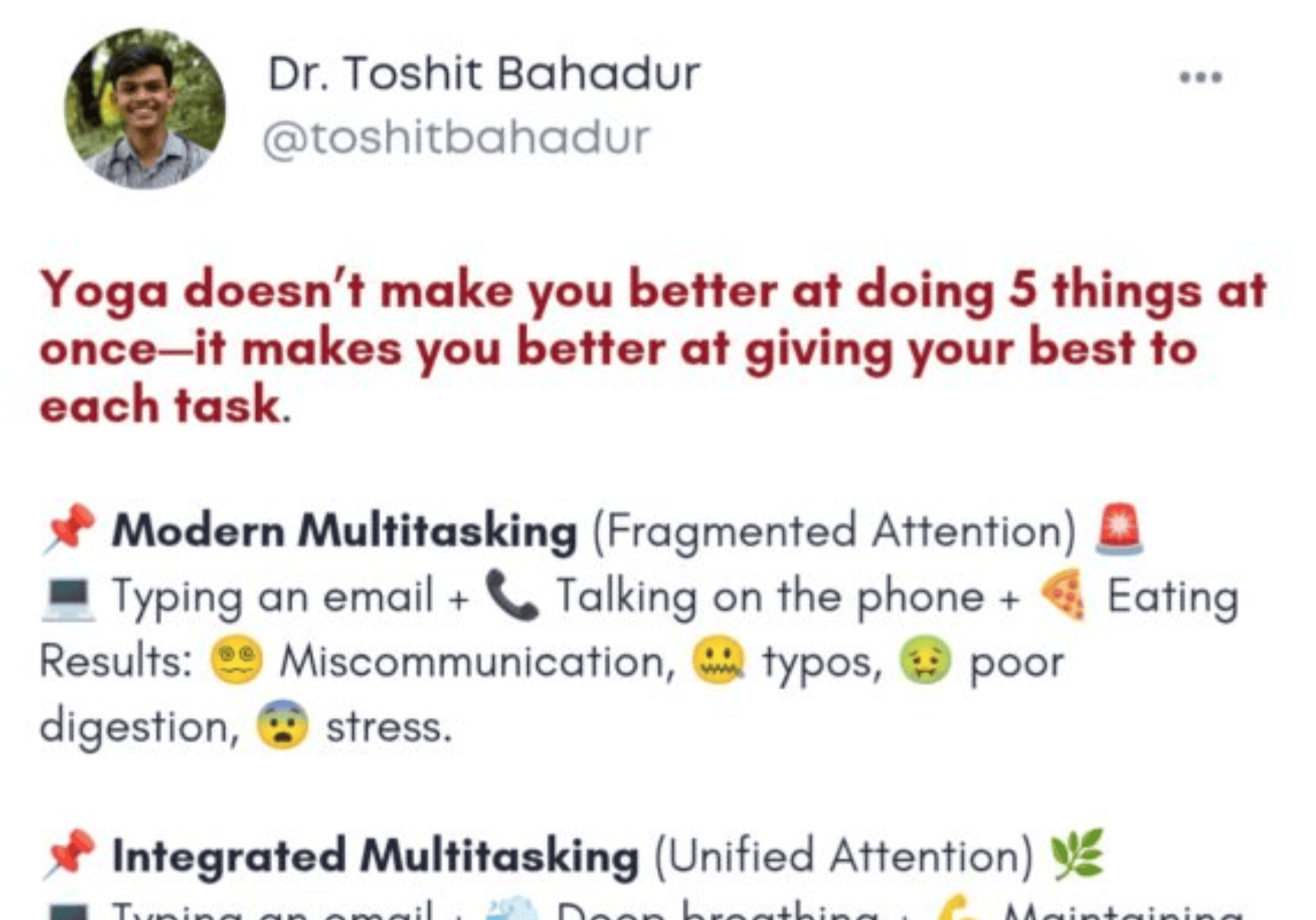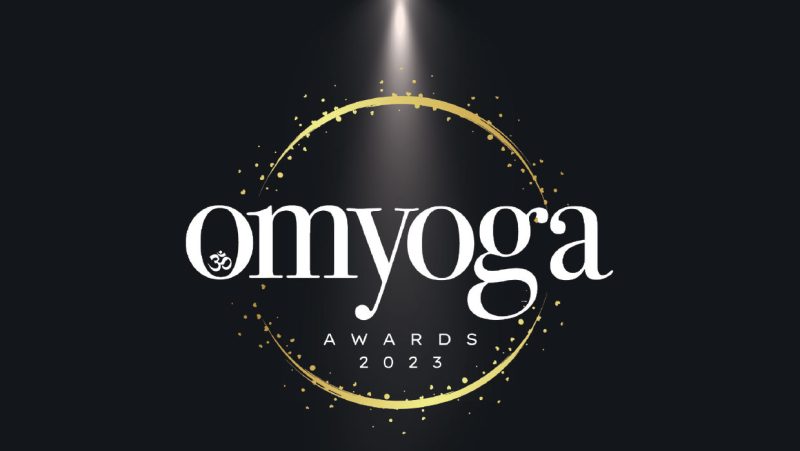
Yoga for Multitasking
In today’s fast-paced world, multitasking has become a badge of honour. People pride themselves on juggling multiple responsibilities at once, believing it makes them more efficient. However, yoga teaches a different approach—one that emphasises deep focus and presence over divided attention.
Reading time: 4 minutes
Yoga doesn’t make you better at doing five things at once; it makes you better at giving your best to each task.
Yoga doesn’t make you better at doing five things at once—it makes you better at giving your best to each task.
- By Toshit Bahadur (Author)
The Myth of Modern Multitasking
The idea that multitasking improves efficiency is a common misconception. Research shows that attempting to perform multiple tasks simultaneously reduces cognitive performance, increases stress, and leads to more errors.
Carl Newport, the author of Deep Work, states, “Efforts to maximise efficiency through multitasking actually reduce efficiency. Constant task-switching kills productivity and creativity.” Similarly, Nobel Laureate Daniel Kahneman explains, “Your mind can only do one thing well at a time. The more you force it to juggle, the more it performs poorly at everything.”
Multitasking often involves rapid task-switching rather than simultaneous execution. Whether responding to emails while attending a meeting or scrolling through social media while studying, the divided attention reduces overall effectiveness. Bill Gates simplifies this with a powerful analogy: “If you chase two rabbits, both will escape.”
Yoga’s Perspective: Focus Over Fragmentation
Yoga teaches that true productivity comes from full engagement with the present moment. The practice of mindfulness in yoga encourages focusing on one task at a time, whether it’s holding a pose, controlling the breath, or meditating.
Swami Vivekananda profoundly stated, “Take up one idea. Make that one idea your life—think of it, dream of it, live on that idea. Let the brain, muscles, nerves, every part of your body be full of that idea.” This principle applies not just to yoga but to life itself.
Mahatma Gandhi’s words also echo this philosophy: “When your hands work, let your mind be still. When your mind works, let your heart be still.” By focusing on the present task, efficiency and quality naturally improve.
Differentiating Modern Multitasking from Integrated Multitasking
Yoga does not advocate for traditional multitasking but does support what can be called integrated multitasking—a harmonious way of performing multiple activities with full awareness.
| Feature | Modern Multitasking | Integrated Multitasking |
| Nature of Attention | Fragmented and divided | Unified and focused |
| Cognitive Load | High, leads to mental fatigue | Low, promotes mental clarity |
| Efficiency | Reduced due to constant task-switching | Enhanced through seamless execution |
| Stress Level | Increases anxiety and errors | Promotes calmness and balance |
| Examples | Replying to emails while watching a video | Walking while practising mindful breathing |
Elon Musk once remarked, “Being busy doesn’t mean being productive. Don’t let yourself drown in distractions.” This underscores the importance of focusing on essential tasks rather than spreading attention thinly across multiple activities.
Example of Integrated Multitasking versus Modern Multitasking in daily life:
Imagine a professional working on an important report while constantly checking notifications, attending a call, and sipping coffee. This fragmented attention reduces productivity, increases errors, and creates mental fatigue.
Unlocking Efficiency: The Yogic Way to Focused Productivity.
Now, consider a yogic approach: the same professional sets aside dedicated time for deep work, focusing solely on writing. Later, during a break, they engage in mindful walking while breathing deeply, allowing relaxation and mental clarity. This approach ensures that both work and self-care are done with full awareness and efficiency.
Integrated Multitasking: The Yogic Approach
Integrated multitasking aligns with yoga’s philosophy of synchronised action—performing tasks in a manner where body, breath, and mind are engaged as one. This approach allows for efficiency without the negative effects of cognitive overload.
Some examples include:
- Breath Awareness While Working: Practicing conscious breathing while performing daily tasks improves concentration and reduces stress.
- Mindful Eating: Eating food with full attention, appreciating the flavours, and chewing thoroughly enhances digestion and well-being.
- Chanting While Walking: Walking meditations or chanting mantras while walking integrates physical movement with mental focus.
- Yoga Practice: Holding a pose while being fully aware of breath, alignment, and muscle engagement.
As Yogananda Paramahansa put it, “Balance action with inner stillness. The greatest productivity comes when thought, breath, and action move in alignment.”
The Benefits of Integrated Multitasking
Embracing integrated multitasking instead of fragmented multitasking brings numerous benefits:
- Improved Cognitive Function – The mind operates more effectively when it is focused, leading to better problem-solving and creativity.
- Reduced Stress and Anxiety – Mindful engagement in activities minimises overwhelm and enhances emotional stability.
- Higher Quality of Work – Attention to detail improves when a person is fully present in their task.
- Enhanced Physical and Mental Well-being – Aligning breath and movement reduces strain and increases overall harmony.
- Stronger Mind-Body Connection – Conscious engagement strengthens neural pathways that link mental awareness with physical actions.
Wisdom from Great Thinkers
Many visionaries and leaders emphasise the power of focus over scattered attention. Steve Jobs once said, “Focusing is about saying no. You have to pick carefully. People think focus means saying yes to the thing you’ve got to focus on. But that's not what it means at all.” This highlights the importance of selective attention and commitment to a singular task.
The Dalai Lama compares an untrained mind to a wild monkey, stating, “The mind is like a wild monkey, jumping from branch to branch. But a trained mind is like a flowing river, doing many things in harmony.” This idea perfectly encapsulates integrated multitasking—performing multiple actions fluidly rather than in disarray.
Martial artist Bruce Lee also supported this approach: “Be like water. Flow with total awareness, not divided attention.” This philosophy encourages adaptability and mindfulness rather than mindless multitasking.
This wisdom, supported by scientific research and timeless philosophies, serves as a powerful reminder that true efficiency lies not in juggling tasks but in mastering the art of focus.





